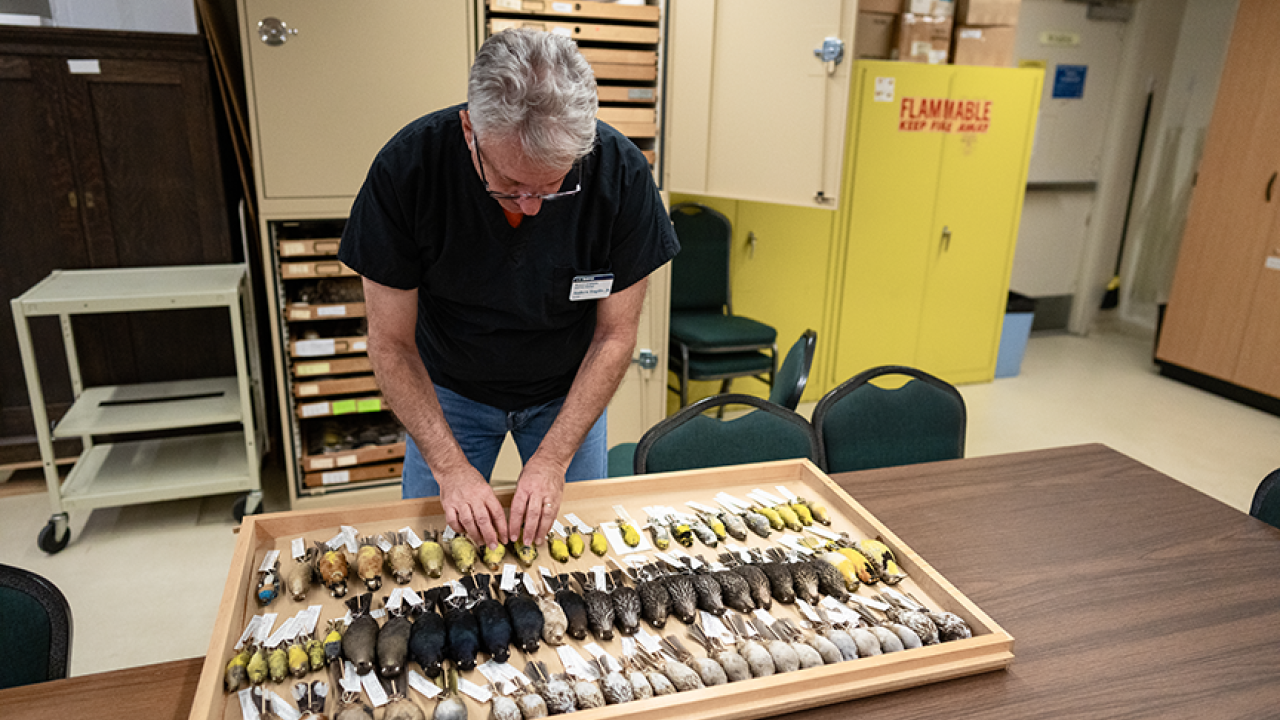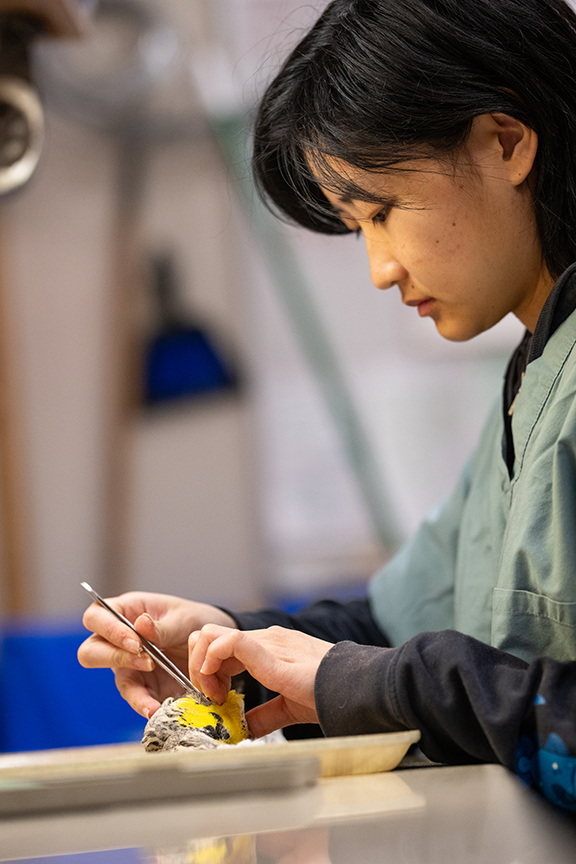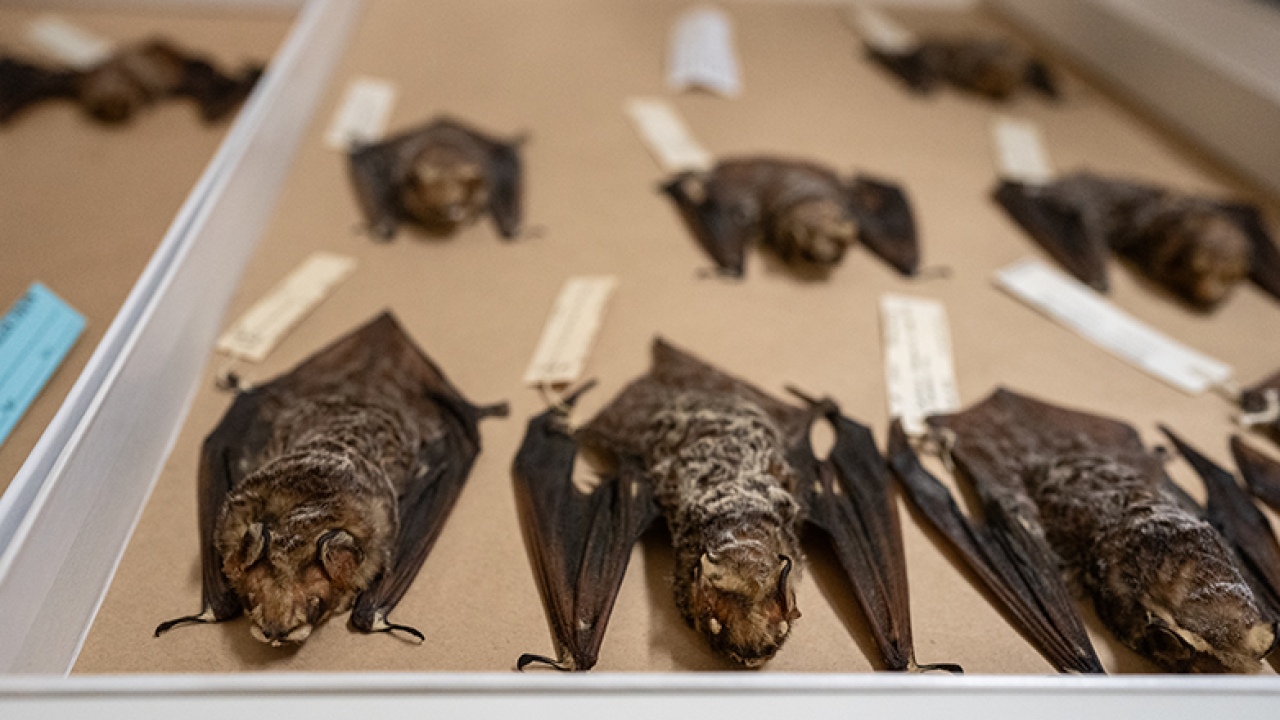
Museum of Wildlife and Fish Biology Chronicles Birdlife in the Sacramento Valley
Project includes 2000 specimens representing more than 190 bird species

In a small laboratory brimming with specialized tools, sophomore Jay Chen delicately handles a western meadowlark, its sunny yellow feathers create a peaceful warmth to the task at hand. Chen is preparing the bird specimen for its place at the UC Davis Museum of Wildlife and Fish Biology, or MWFB.
Chen, a museum intern who is majoring in wildlife, fish and conservation biology, is contributing to the avian inventory of the Sacramento Valley, a research project led by the museum to create a record of birdlife in the region. Museum curator Andrew “Andy” Engilis said a resource like this will provide important information for years to come.
“Our efforts to chronicle bird diversity from the Sacramento Valley, with specimens, will provide a baseline that no one else has done,” Engilis said. “The value of this collection is high to us now, but it’s going to be critically important to scientists 50 to 100 years from now,” Engilis said.
The western meadowlark that Chen prepared is one of over 2,000 specimens representing more than 190 bird species acquired by the museum. Each bird’s story is being recorded. For instance, this western meadowlark was discovered lifeless along Country Road 29 just north of Davis. Chen appreciates that not only is she following her passion, but her work in preserving these birds is essential for conservation and scientific research now and in the future.
“I’ve always been interested in taxidermy, but it’s not something you can learn on your own, so being able to learn this and make something that is not just on display but something that scientists will use is really cool,” Chen said.
Untold story
The project launched in 2016 when Engilis started sifting through historical avian records left behind by the late John Emlen, a UC Davis zoologist who conducted bird counts in the 1930s. Engilis said he realized there was an untold story among those records and set out to chronicle every bird in the valley to create a diversity benchmark for the 21st century.
The museum started obtaining specimens in 2017 through its own research efforts, and accepted hundreds of bird specimens donated by the Sacramento-Yolo Mosquito and Vector Control District and other state agencies.
“We have received some species of birds that have never been recorded in the Sacramento Valley ever,” Engilis said.

One such bird is a blackburnian warbler. Engilis said biologists with the agency assumed it was a commonly found bird, but he quickly realized it was a rarity. The species hails from Eastern Canada and migrates down the Atlantic Flyway. Engilis said this bird probably got lost during migration before it fatally crashed into a window at a home in Carmichael.
The museum was also given a flammulated owl that a homeowner in Land Park discovered in her backyard. Coincidentally, she shared a photo of it on social media and a local birder who saw the post alerted the museum. Engilis said it was a valuable find because that small migratory owl is rarely seen in the Sacramento region. The museum also has several specimens of the tricolored blackbird, donated by a UC Davis researcher. This species, which has seen a significant decline in population, was recently listed as a threatened species under the California Endangered Species Act.
Engilis and his team are preparing a monograph, a large paper that will characterize the bird life of the valley based on the specimens collected. The inventory will be organized by county, featuring what species were discovered in each county.
“Paying specimens forward to the next generation of scientists is one of the most important things we can do to understand changes in diversity, effects of climate, the evolutionary process of species and more, and that’s what these specimens are going to be used for,” Engilis said.

Invaluable interns
Engilis credits student interns for being the major work force behind this endeavor. The museum’s internship program engages students at all levels – from working in the field to carefully curating specimens. Engilis said students have logged more than 10,000 hours of work as part of this project.
Cassie Huang, a fourth-year microbiology major, has cataloged thousands of specimens since becoming a museum intern during her first year at UC Davis. She has demonstrated impeccable attention to detail, filling out small tags with a great amount of vital information like measurements, collection date and location, genus, species, and more.
“We have huge trays full of birds and seeing all the birds I’ve worked on lined up with the tags on them is really satisfying,” Huang said.
Irene Engilis, the museum’s collections manager, coordinates access to specimens that are used for research and teaching. She started as an intern at MWFB as an undergraduate and now advises the nearly 20 interns at the museum.
“I want as many students as possible to have this experience because it had such a huge impact on my life,” she said.
Both Andy and Irene are proud that many of their interns have gone on to start careers all over the world, including a recent intern who has since graduated and is now a specimen preparator at the Denver Natural History Museum.
“The internship program is a unique component of our department,” Engilis said. “By the time they leave, they are well trained as vertebrate biologists.”

What’s next?
This summer, interns will embark on the next museum project: creating an inventory of bats from around California. Following a similar model as the bird inventory, Engilis said they hope to develop a record of as many species of the nocturnal flying mammal as possible to create the most comprehensive collection of modern bat specimens housed in any museum in the state.
As of February, the museum secured more than 600 bats from 40 California counties from the California Department of Fish and Wildlife. Through funding from state grants, students will start preparing and curating the specimens in the coming months. They’ll also preserve the animal’s tissues as part of the museum’s archive of genomic material for future scientists.
“Each specimen is like a little time capsule, it’s a snapshot in time of what’s happening in our region,” Engilis said. “I can’t even comprehend what scientists will be able to do with them decades from now.”
Media Resources
- Andy Engilis, Museum of Wildlife and Fish Biology, aengilisjr@ucdavis.edu
- Irene Engilis, Museum of Wildlife and Fish Biology, ieengilis@ucdavis.edu
- Tiffany Dobbyn, College of Agricultural and Environmental Sciences, tadobbyn@ucdavis.edu
To learn more about this and other MWFB programs visit: https://mwfb.ucdavis.edu/.